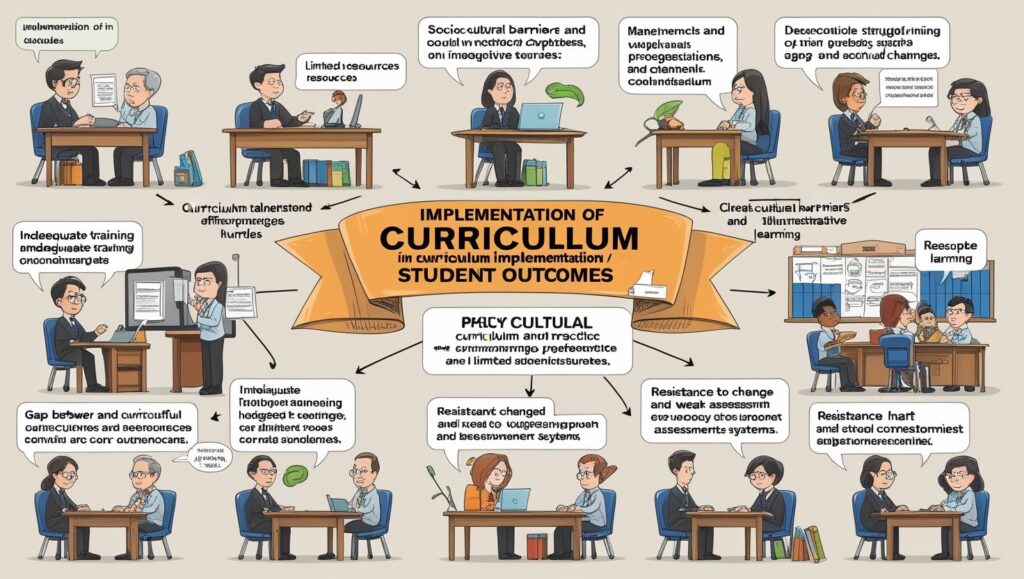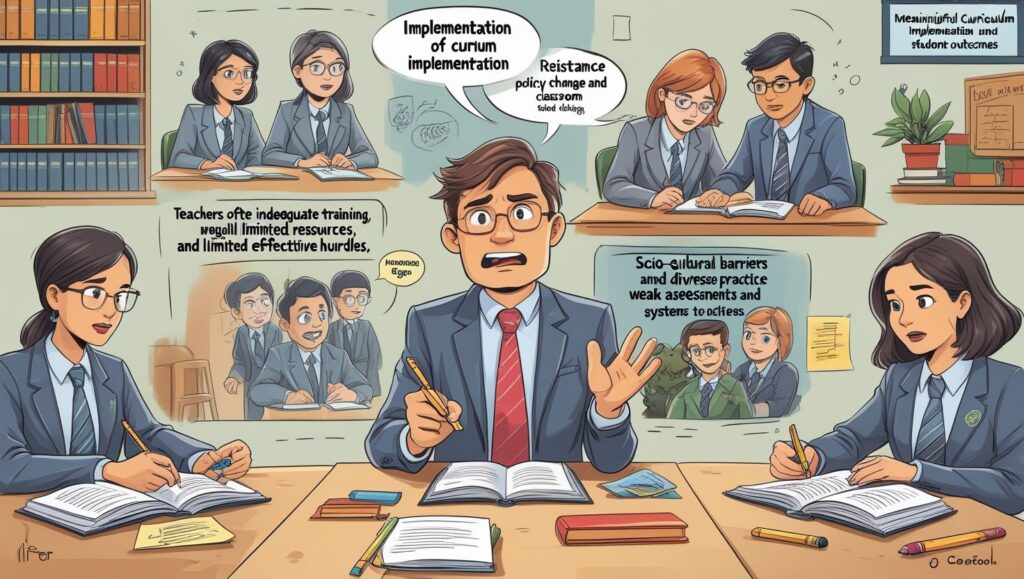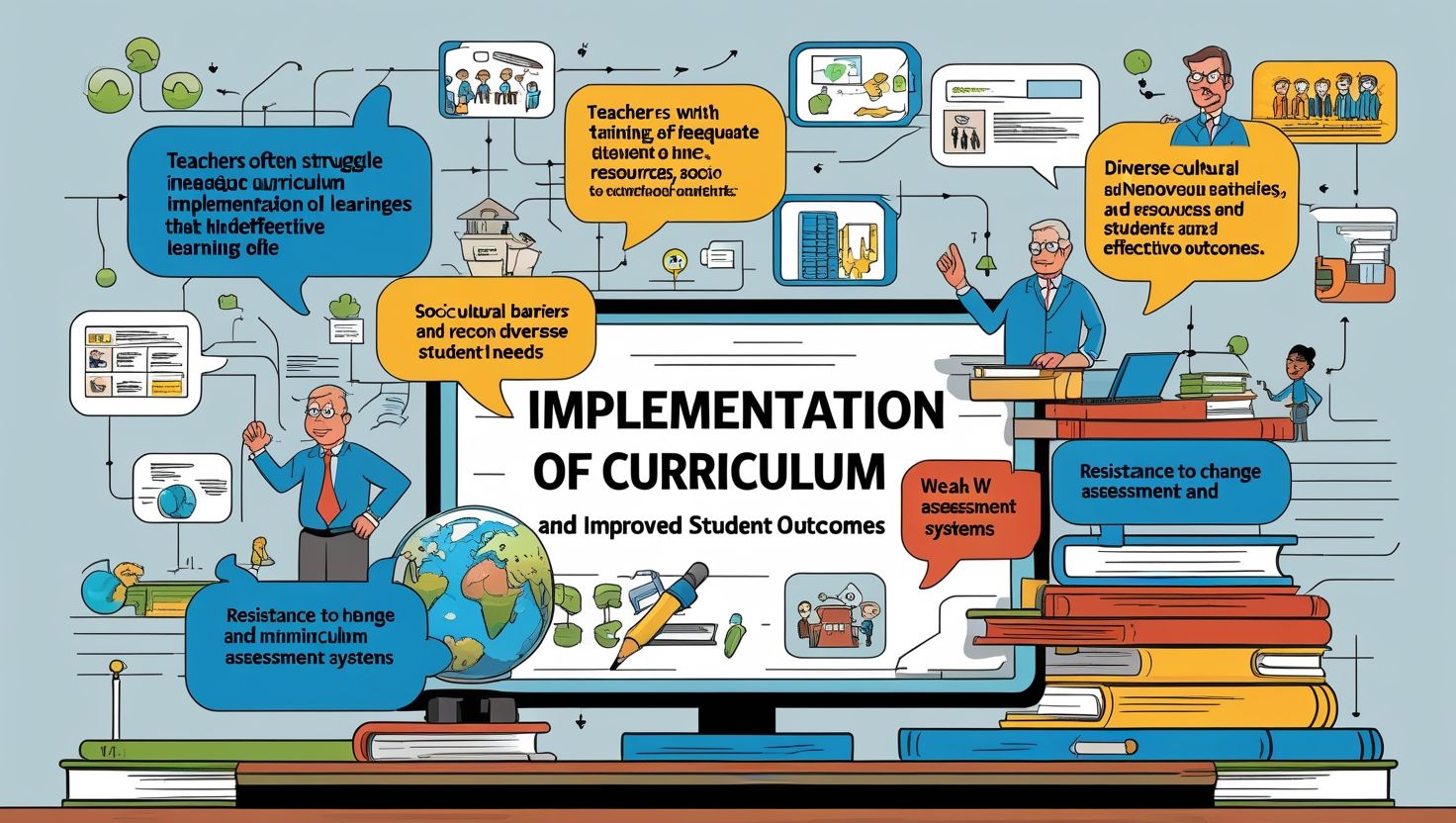Introduction
Implementation Issues of Curriculum in Schools, Curriculum is the backbone of any educational system. It provides a structured framework for learning and guides both teachers and students toward academic success. However, the real challenge lies not in curriculum design but in its effective implementation within schools. Implementation involves translating theoretical plans into classroom practices, which often faces multiple obstacles. These issues may arise due to lack of resources, teacher preparedness, administrative hurdles, or socio-cultural factors. Moreover, the gap between policy makers and practitioners often leads to inconsistencies in delivery. Effective implementation requires collaboration among teachers, school leaders, parents, and students. Monitoring and evaluation are also crucial to ensure alignment with educational goals. Without addressing these barriers, even the most well-designed curriculum fails to achieve its objectives. Therefore, understanding and solving implementation issues in schools is vital for creating a dynamic and meaningful learning environment that fosters holistic student development.
Teacher Preparedness
Teachers are the primary agents of curriculum delivery, yet many face challenges due to inadequate preparation. Some teachers lack proper training in curriculum interpretation, making it difficult to align teaching with expected outcomes. Professional development programs are often limited, leaving teachers with outdated methods. Additionally, many educators struggle to balance new curriculum demands with existing workloads. Resistance to change also emerges, especially when teachers are not involved in curriculum design. Furthermore, unequal access to teaching resources hinders consistency in implementation. For example, rural teachers may not have access to advanced teaching materials compared to urban counterparts. Effective curriculum implementation requires regular training workshops, mentoring, and peer collaboration. Moreover, teachers need to be empowered with flexibility to adapt content to student needs. Addressing teacher preparedness ensures that classroom practices reflect curriculum goals, thereby bridging the gap between policy and practice in schools.
Lack of Resources
Resource scarcity remains a major barrier in curriculum implementation across schools. Many institutions operate with limited textbooks, outdated technology, and insufficient teaching aids. Without proper resources, teachers cannot fully deliver curriculum objectives. Additionally, overcrowded classrooms make it challenging to provide personalized instruction. Infrastructure issues, such as inadequate classrooms, poor libraries, and lack of laboratories, further hinder effective learning. Furthermore, digital tools, which are now essential in modern curricula, are not equally accessible in all schools. Rural and low-income communities often struggle the most. Limited budgets restrict schools from investing in modern teaching materials and equipment. As a result, the intended curriculum often remains theoretical rather than practical. Addressing this issue requires government support, equitable funding, and partnerships with NGOs and private organizations. By ensuring adequate resources, schools can provide an environment that supports both teachers and students in achieving curriculum goals effectively.

Administrative Challenges
School administration plays a crucial role in curriculum implementation. However, weak management often creates obstacles. Many administrators lack proper training in curriculum planning and monitoring. They may focus more on routine operations rather than instructional leadership. Additionally, frequent changes in school policies create confusion among staff. Bureaucratic delays also slow down the provision of resources and teacher support. Moreover, administrators sometimes fail to involve teachers in decision-making, reducing their motivation to implement changes. In some cases, political interference affects curriculum priorities, diverting attention from core educational objectives. Strong leadership is essential for overcoming these challenges. Administrators must provide clear guidance, organize teacher training, and ensure accountability. Furthermore, they should encourage collaboration between teachers and parents to create a supportive learning environment. Effective administration not only resolves challenges but also ensures that curriculum implementation aligns with national education standards and school-level objectives.
Socio-Cultural Barriers
Curriculum implementation often encounters socio-cultural barriers within schools. In diverse societies, cultural differences may conflict with standardized curriculum content. Some communities may resist topics they find culturally inappropriate or irrelevant. Additionally, language barriers affect curriculum delivery, especially in multilingual regions. Students may struggle to understand content taught in a language different from their home language. Gender biases in society also influence how curriculum goals are perceived and applied. For instance, girls may face restrictions in pursuing certain subjects. Moreover, parental expectations sometimes clash with curriculum demands, creating confusion for students. Teachers also bring their cultural values into classrooms, which may influence their interpretation of the curriculum. Addressing socio-cultural barriers requires culturally responsive teaching strategies, inclusion of local contexts, and community involvement. By respecting cultural diversity while maintaining academic standards, schools can implement curricula that are both effective and socially relevant.
Student Diversity
Students vary in abilities, learning styles, and socio-economic backgrounds, making curriculum implementation complex. Standardized curricula often fail to meet the diverse needs of all learners. For example, students with diffeerent needs may find it difficult to cope with mainstream content without proper support. Similarly, gifted students may feel under-challenged, leading to disengagement. Language proficiency differences also affect learning outcomes, especially for second-language learners. Moreover, socio-economic disparities influence access to learning materials and parental support. Teachers face challenges in adapting curriculum content while managing large and diverse classrooms. Differentiated instruction, inclusive education strategies, and use of technology can help address these issues. Additionally, formative assessments allow teachers to identify and respond to individual learning needs. Recognizing student diversity is crucial to bridging the gap between curriculum goals and student realities. By addressing these challenges, schools can ensure equitable learning opportunities for all students.
Assessment Issues
Assessments play a critical role in curriculum implementation, yet they often create challenges. Many schools still rely on traditional examinations that focus on rote memorization rather than critical thinking. This limits the scope of curriculum objectives, which emphasize creativity, problem-solving, and practical skills. Additionally, standardized testing creates pressure on students and teachers, often narrowing the curriculum to test-related topics. Teachers may also lack training in designing diverse assessment methods such as projects, portfolios, or performance-based tasks. Furthermore, insufficient feedback mechanisms prevent students from improving their learning outcomes. In some cases, assessment results are not used effectively for curriculum review and adjustment. Addressing these challenges requires adopting comprehensive assessment systems that evaluate cognitive, emotional, and practical skills. Continuous and formative assessments should be prioritized over high-stakes testing. By reforming assessment practices, schools can ensure that curriculum implementation reflects holistic learning goals.

Resistance to Change
Resistance to change is a common issue during curriculum implementation. Teachers, administrators, and even parents may hesitate to adopt new methods due to fear of the unknown. Many educators are comfortable with traditional teaching practices and resist modern pedagogical approaches. Additionally, curriculum reforms are often introduced without sufficient consultation, leading to lack of ownership. Parents may also question the relevance of new content, especially if it conflicts with traditional expectations. Moreover, resistance grows when stakeholders perceive reforms as burdensome rather than beneficial. Lack of proper communication and training intensifies this problem. Overcoming resistance requires involving all stakeholders in the decision-making process. Training workshops, awareness campaigns, and pilot programs can reduce hesitation. Encouraging open dialogue between policymakers and practitioners fosters trust. By gradually introducing changes and demonstrating their benefits, schools can overcome resistance and ensure smoother curriculum implementation.
Policy-Practice Gap
One of the biggest hurdles in curriculum implementation is the gap between policy and practice. Policymakers design ambitious curricula with clear objectives, but these often fail during classroom delivery. Limited communication between curriculum developers and teachers widens this gap. Teachers may misinterpret curriculum guidelines or lack support in applying them. Additionally, policies sometimes ignore ground realities such as resource availability and teacher workload. Frequent policy changes without adequate training further complicate matters. Moreover, policymakers may emphasize theoretical ideals without considering local contexts. Bridging the policy-practice gap requires stronger collaboration between developers, teachers, and administrators. Pilot testing new curricula before nationwide adoption can also reduce challenges. Feedback from teachers and students should inform revisions. Aligning policy with classroom realities ensures that curriculum objectives translate into meaningful learning experiences. Without addressing this gap, even the best curriculum frameworks remain ineffective in practice.
Technology Integration Challenges
Modern curricula emphasize the use of digital tools, but technology integration faces multiple challenges. Many schools lack reliable internet connections, updated devices, or sufficient digital literacy among teachers. Even when technology is available, some teachers are reluctant to use it due to lack of training. Students from low-income families may also lack access to devices at home, creating inequality in digital learning. Moreover, over-reliance on technology can sometimes reduce face-to-face interaction, affecting social skills. Technical issues such as system failures or software incompatibility further disrupt implementation. To overcome these barriers, schools must invest in infrastructure and teacher training. Digital literacy programs for students and parents can also support integration. Blended learning models, which combine online and offline methods, offer a practical solution. By addressing these challenges, schools can ensure that technology supports curriculum goals rather than creating additional obstacles.
Conclusion
Curriculum implementation in schools is a complex process influenced by multiple factors. Teacher preparedness, resource availability, administrative efficiency, socio-cultural dynamics, and assessment practices all play crucial roles. Student diversity and resistance to change further complicate the process. Moreover, gaps between policy and practice, along with challenges in technology integration, continue to hinder progress. However, these issues are not insurmountable. Collaborative efforts among policymakers, teachers, parents, and students can create solutions that make curriculum implementation more effective. Continuous training, equitable resource distribution, and inclusive teaching practices are essential. Furthermore, adopting innovative assessment methods and leveraging technology responsibly can enhance delivery. By addressing these issues, schools can ensure that curriculum goals translate into meaningful learning outcomes. Ultimately, successful curriculum implementation shapes the quality of education and prepares students for the challenges of the future.
References
- Fullan, M. (2007). The New Meaning of Educational Change. Teachers College Press.
- Ornstein, A. C., & Hunkins, F. P. (2018). Curriculum: Foundations, Principles, and Issues. Pearson Higher Ed.
- Tyler, R. W. (2013). Basic Principles of Curriculum and Instruction. University of Chicago Press.
- Kelly, A. V. (2009). The Curriculum: Theory and Practice. Sage Publications.
- Marsh, C. J., & Willis, G. (2007). Curriculum: Alternative Approaches, Ongoing Issues. Pearson.

jxncsy
I truly appreciate this post. I have been looking all over for this! Thank goodness I found it on Bing. You have made my day! Thx again
bq4358
rlgi33
Make mornings more adorable with this Hello Kitty alarm clock CD player. Ideal for kids and collectors alike, this charming CD clock radio includes all the basics: AM/FM radio, programmable CD playback, and reliable alarm settings. Wake up to your favorite CD or a cheerful radio station with built-in stereo sound. A large digital display and simple controls make it easy to use, even for younger users. Combining cuteness with functionality, it’s a top pick among themed alarm clocks with CD players that bring fun and joy to your space.
I’ve been absent for a while, but now I remember why I used to love this site. Thank you, I’ll try and check back more often. How frequently you update your site?
It’s perfect time to make some plans for the future and it’s time to be happy. I have read this post and if I could I wish to suggest you some interesting things or suggestions. Maybe you can write next articles referring to this article. I desire to read more things about it!
Today, I went to the beachfront with my kids. I found a sea shell and gave it to my 4 year old daughter and said “You can hear the ocean if you put this to your ear.” She put the shell to her ear and screamed. There was a hermit crab inside and it pinched her ear. She never wants to go back! LoL I know this is completely off topic but I had to tell someone!
Today, I went to the beachfront with my kids. I found a sea shell and gave it to my 4 year old daughter and said “You can hear the ocean if you put this to your ear.” She put the shell to her ear and screamed. There was a hermit crab inside and it pinched her ear. She never wants to go back! LoL I know this is completely off topic but I had to tell someone!
Wow! Thank you! I continually wanted to write on my blog something like that. Can I take a fragment of your post to my site?
I feel this is among the such a lot significant information for me. And i am happy studying your article. But wanna commentary on few general issues, The web site style is perfect, the articles is in reality excellent : D. Just right job, cheers
Excellent post. I was checking continuously this blog and I am impressed! Very helpful info particularly the last part 🙂 I care for such information much. I was seeking this certain information for a very long time. Thank you and best of luck.
Just a smiling visitor here to share the love (:, btw outstanding design. “Make the most of your regrets… . To regret deeply is to live afresh.” by Henry David Thoreau.
Istanbul half day tour Our guide made history come alive during the old city walk. https://tiesawards.com/istanbul-city-tours.html
Bosphorus bridge tour Would love to book another tour with them. https://www.budgettoursturkey.com/12-days-eastern-anatolia-tour.html
Istanbul full day tour The boat ride on the Bosphorus was magical at sunset. https://www.istta.org.tr/pamukkale-tours.html
Good – I should certainly pronounce, impressed with your site. I had no trouble navigating through all tabs as well as related info ended up being truly easy to do to access. I recently found what I hoped for before you know it in the least. Reasonably unusual. Is likely to appreciate it for those who add forums or something, website theme . a tones way for your customer to communicate. Excellent task.
Heya! I’m at work browsing your blog from my new iphone 4! Just wanted to say I love reading your blog and look forward to all your posts! Keep up the great work!
I just like the helpful info you supply to your articles. I will bookmark your weblog and check once more right here regularly. I’m rather certain I’ll learn plenty of new stuff right right here! Good luck for the following!
hello there and thanks to your info – I’ve certainly picked up something new from proper here. I did however expertise some technical issues the use of this web site, since I experienced to reload the web site lots of occasions prior to I may just get it to load correctly. I were pondering in case your web hosting is OK? Now not that I’m complaining, however slow loading instances times will very frequently impact your placement in google and can damage your high quality ranking if advertising and ***********|advertising|advertising|advertising and *********** with Adwords. Well I am adding this RSS to my e-mail and can glance out for a lot extra of your respective interesting content. Ensure that you replace this again soon..